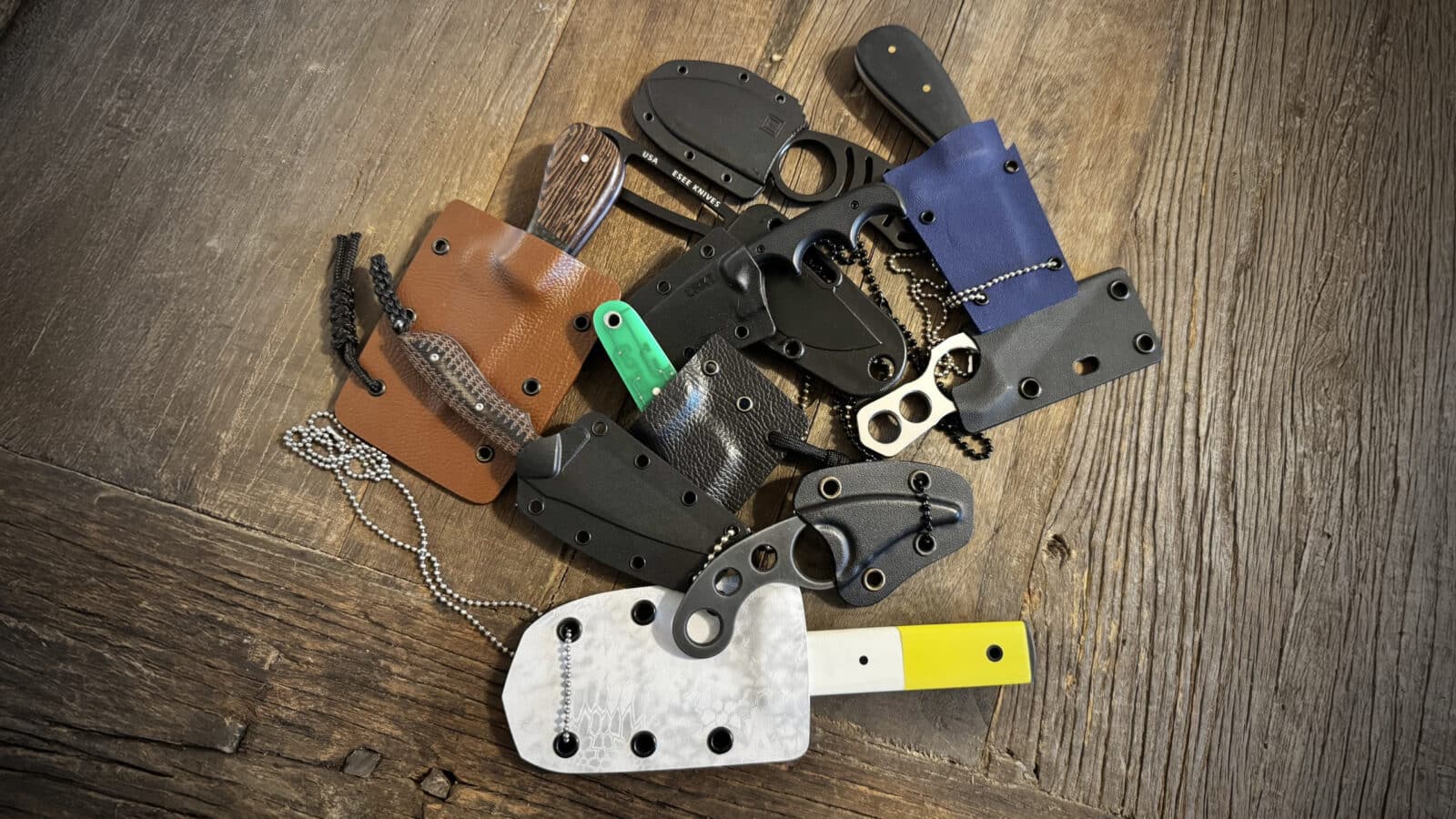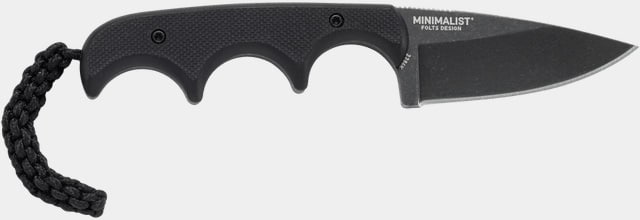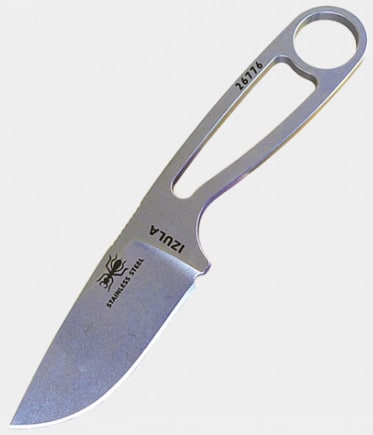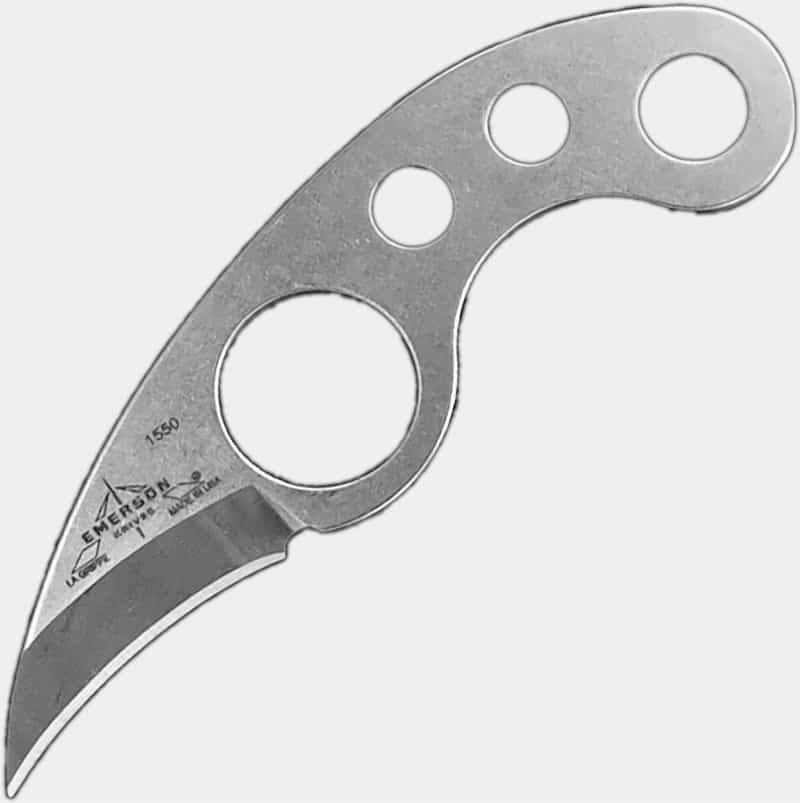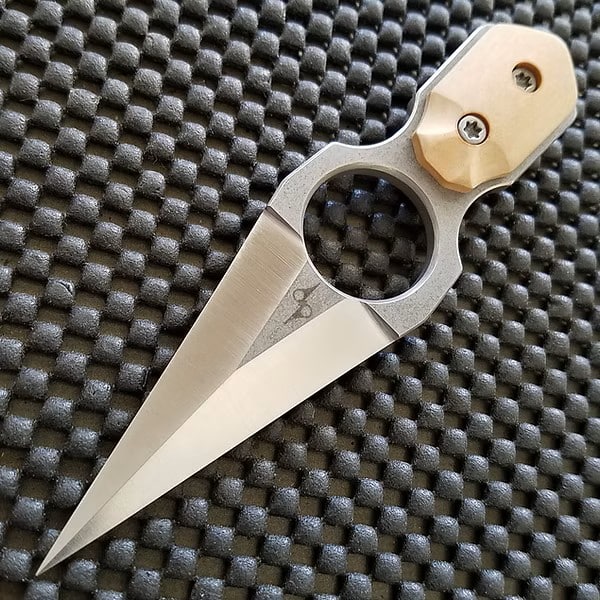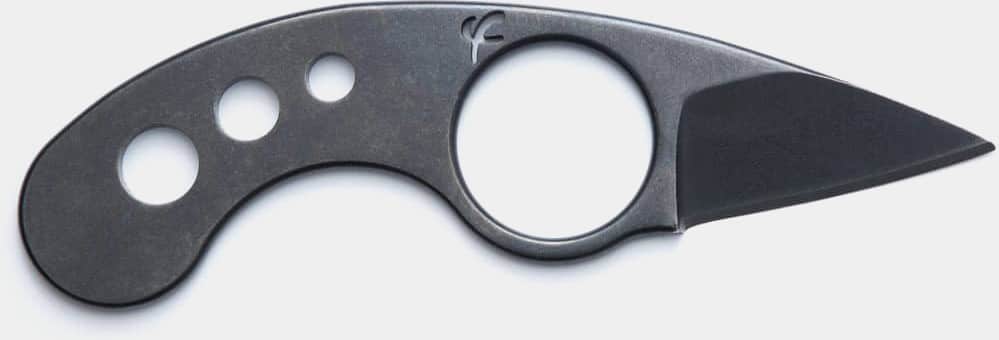While inspecting my paddleboarding gear in the garage, I took out my small water knife for sharpening. Mine is a simple utility style I made from an unused piece of 154CM stainless steel and some scrap G10 scales. The rusty ball chain attached to the polymer sheath needed to be replaced. Why? Because it supports the knife for around-the-neck carry.
What Is a Neck Knife?
Neck knives are small, sheathed blades suspended from a lanyard and carried at sternum level. My knife travels with me on the water in this manner because my loose swim shorts do not support the pocketing of a folder very well. Nor is the drawstring compatible with a belt sheath. Paddling is a minimalist thing for me.
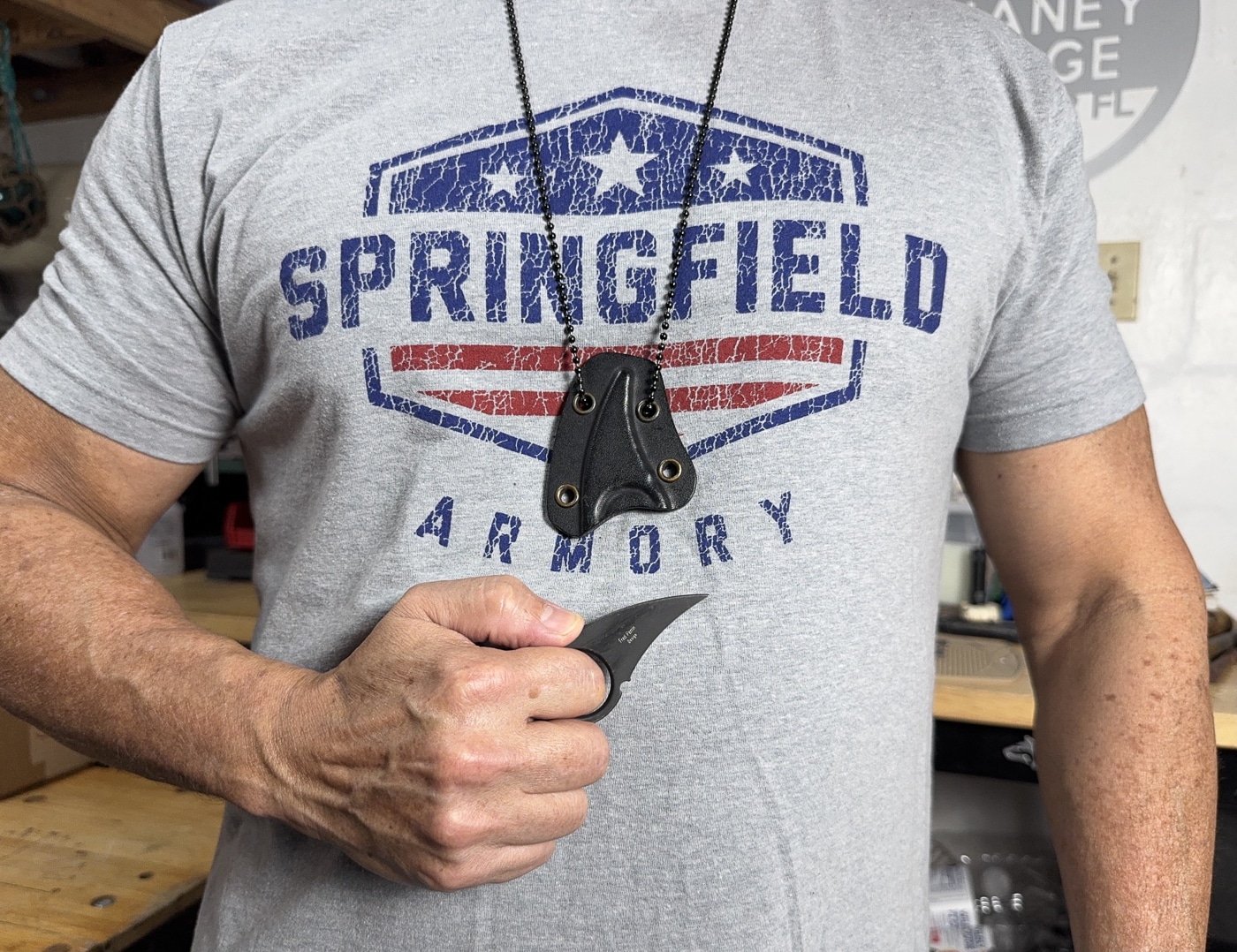
This is one example of lanyard carry for a blade. Neck knives are used for utility and self-defense. Although a folding knife can be fitted with a thermoplastic sheath (Kydex, Boltaron, or some polymer) for lanyard duty, most neck knife aficionados prefer a fixed blade for its strength, low profile and quick deployment.
So, why the neck knife? As in my case, it is the best platform. Neck knives are handy in a pinch, as they are carried at your centerline and only require a quick reach into your shirt when you need something sharp, whether to cut a cord, open a package, strip a wire, or poke something that needs … poking. They provide ambidextrous access when duty calls.
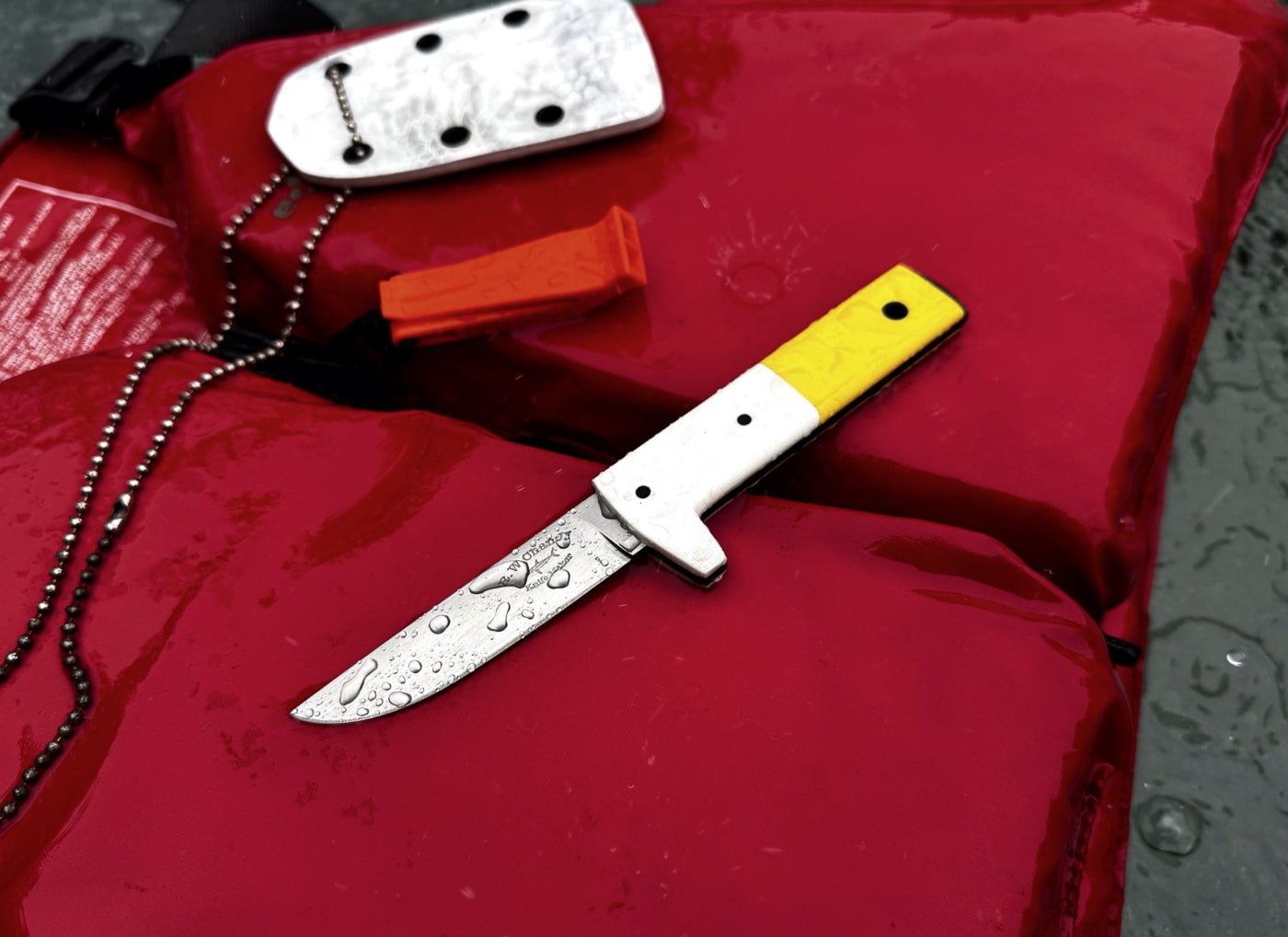
Ease is also the reason why folk like them for defensive use. Drawing one is not so unlike that from an AIWB holster. A furtive movement under the garment gains access. Presentation shields the vital areas. While this should normally not be your first line of defense, it can be a reliable backup. Or backup to your backup.
In a Gun-Free Zone, this may be your only safety call. Laws vary from one local region to another, from state to state, and in federally regulated areas. Knowledge is more powerful than bail money, so do your due diligence before venturing into the great unknown.
The Options
The neck knife’s blade style may be dictated by use. A utility blade can be a standard drop point, such as the Columbia River Knife and Tool (CRKT) Minimalist or the excellent ESEE Knives Izula. I discovered the Izula is right for small bushcraft tasks when a larger knife or axe is too much blade.
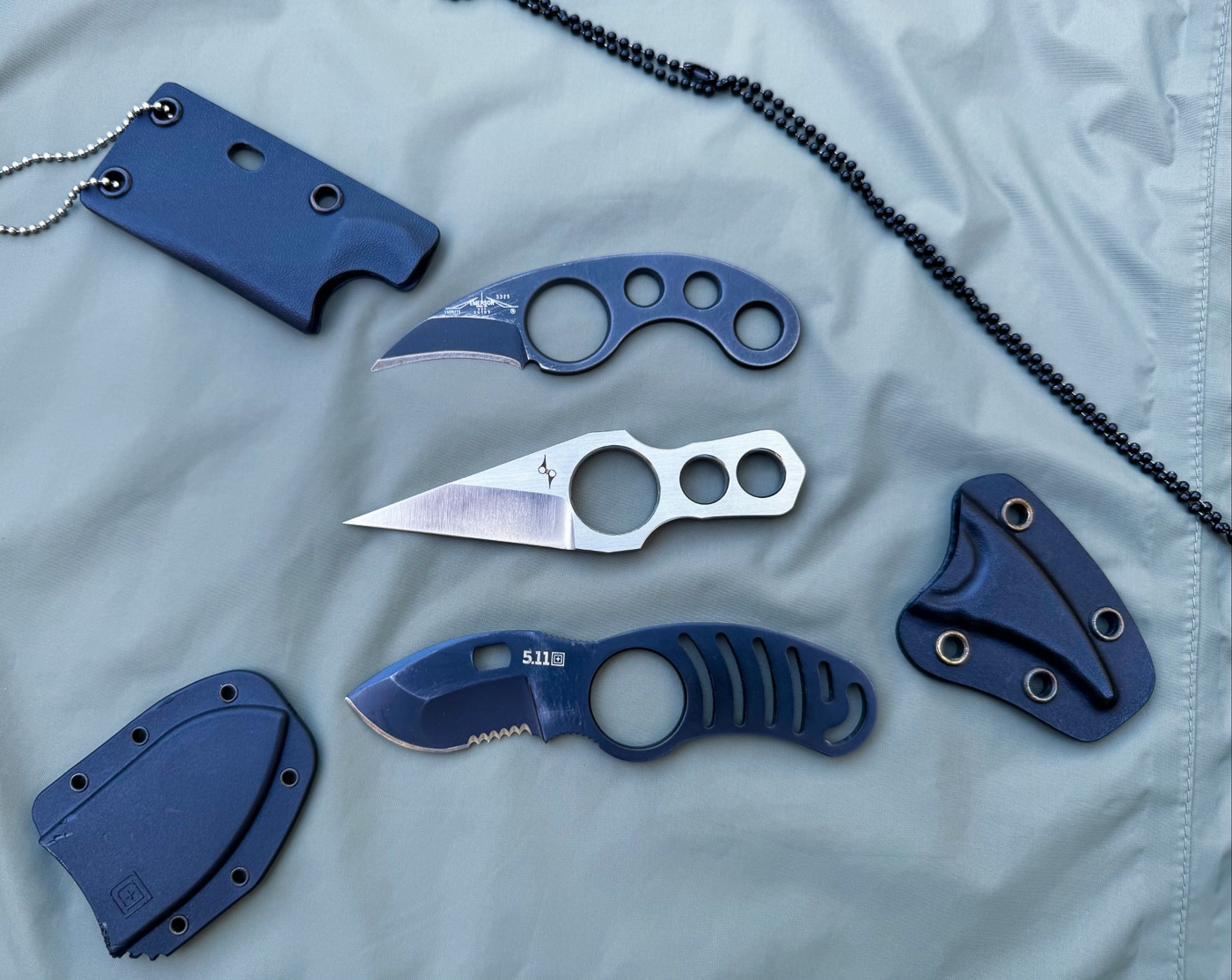
For self-defense, a more exotic shape, such as the hawksbill Emerson Knives La Griffe, makes for a formidable deterrent. Also in the SD realm, there are straight edges, as on the CRKT S.P.E.W. or custom Dirk Pinkerton Broadhead. These Wharncliffe-style profiles exert extra positive pressure at the edge and are recommended by martial trainers such as Michael Janich.
While a foot of knife like the Bear & Son Bowie might be an excellent cutter, it would hang off your neck like a draught animal’s wooden yoke. Neck knives typically compromise on blade length. While a one-inch Kiridashi can soldier through daily tasks, I believe the sweet spot for a neck blade is two to three and a half inches, considering the knife’s overall size.
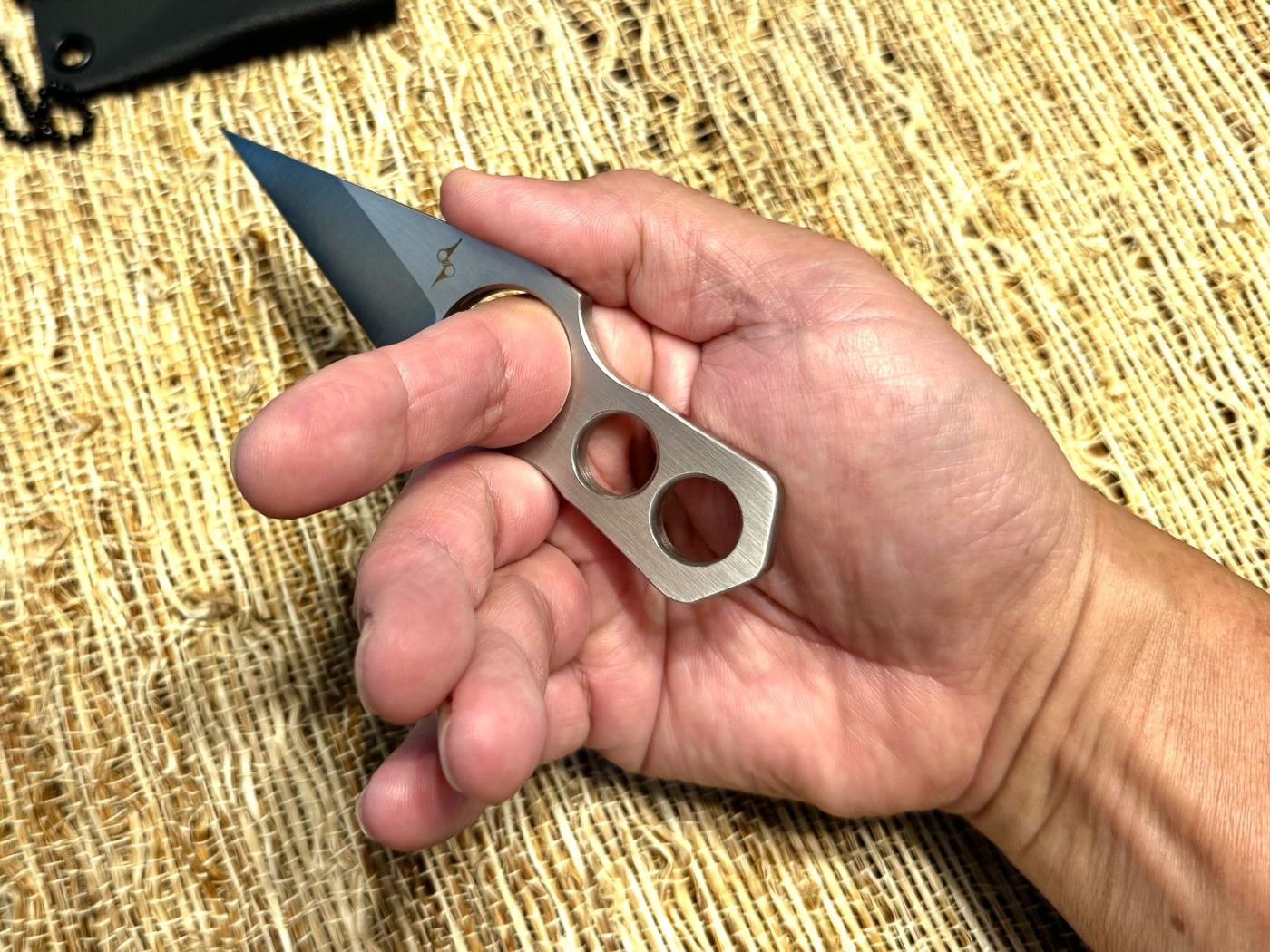
The steel is your preference, but since it will be carried close to the body, non-stainless, high-carbon steel should be coated for added protection. That can be a durable application, such as a baked or cured coating, a good wax, or diligent care with frequent cleaning and oil. High-chromium stain-resistant steels offer less maintenance, but do not eliminate the chore. Enjoy.
Three of my neckers have the signature finger hole popularized by French knife maker and martial artist Fred Perrin. The Emerson La Griffe is a direct homage to Perrin. The forward finger ring can aid in locating the handle under the shirt, index the knife in the hand, and secure it during hard use. Perrin originally designed his La Griffe (the claw) as an everyday neck-carrying knife.
The handle of a neck knife may be a three-finger affair to shorten the knife’s length. A finger hole, pronounced finger wells or a braided rear lanyard can make a diminutive handle more useful in the hand. Alternatively, you may opt for a full-size. My water knife is seven and a half inches from tip to butt. It is unnoticeable to me.
A longer neck knife can be worn under a T-shirt without attracting much attention, as it does not print like a handgun. Like concealed pistol carry, a loose-fitting garment can camouflage what is underneath. A knife handle is not as obvious as that on a gun. Positioned at the center chest, most folks would not even consider an object there as a tool or weapon.
Carry Details
The sheath of a neck knife is important because retention is crucial, as the blade is carried inverted. As mentioned above, synthetics like Kydex, Boltaron and similar plastics are preferred for their grip on the knife, but also for their ease of draw. Their rigidity prevents the steel from inadvertently puncturing the wearer. For a knife carried close to the body, non-corroding brass rivets and/or stainless fittings are preferable.
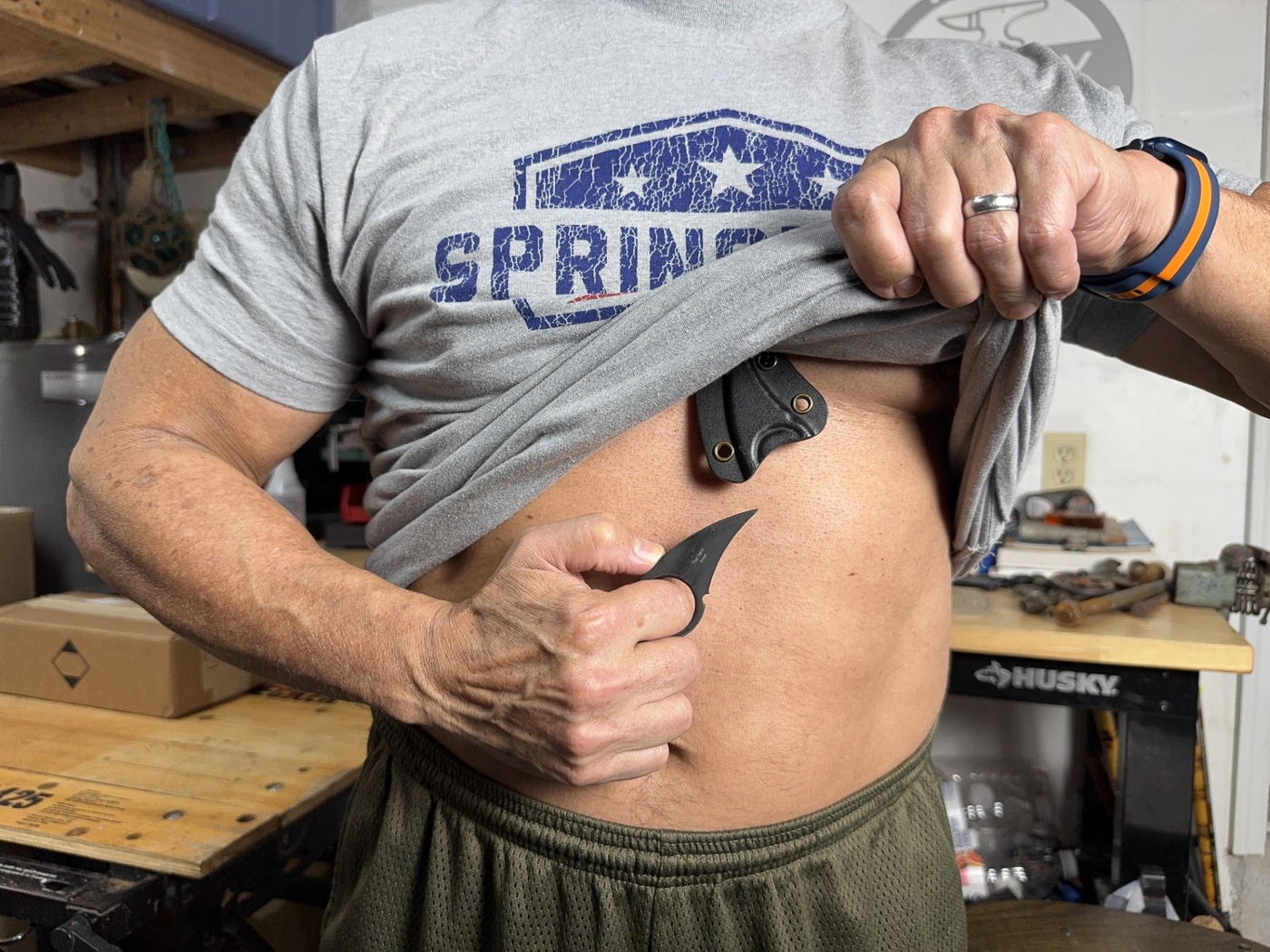
Leather or other organic materials would not constitute reliable media for a neck knife sheath, as they would degrade and loosen any friction fit over time. A snapped retaining strap might work, but would only complicate the draw. Polymers are definitely the way to go here.
Neck carry. As to the Heffalump in the room — the lanyard. I have seen so many neck knives on the Internets worn on paracord that I am just short of homicidal over the reckless wearing of such a useful implement. Just say no to the ligature. Seriously. I hope I am not alone here, but wearing an instrument of strangulation is not on my menu.
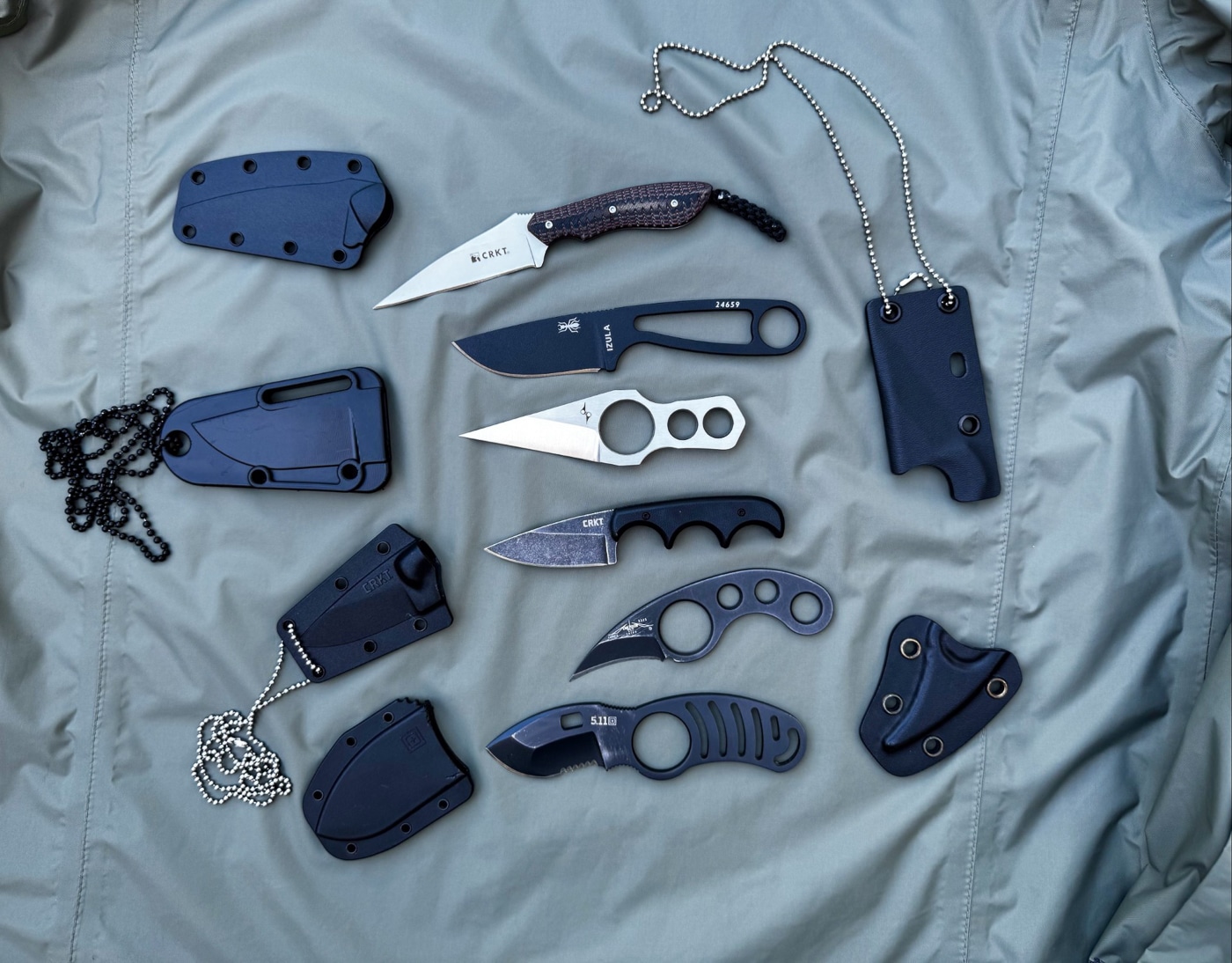
A neck knife should only be worn on a breakaway ball chain lanyard. End of story. Before you trust your circulation and respiration to a ball chain, some research is in order. Their materials and makeup vary in critical respects. And, yeah, size matters.
Mil-spec ball chain for dog tags is a stainless steel #3 chain with a tensile strength of 25 pounds. For carbon steel or brass, the breaking point is 20 pounds of pressure. These are below what is needed for an effective garrote. Safety first. Stainless steel and brass are corrosion-resistant, as are coated chains. The #3 chain balls measure 3/32 inches or 2.5 mm.
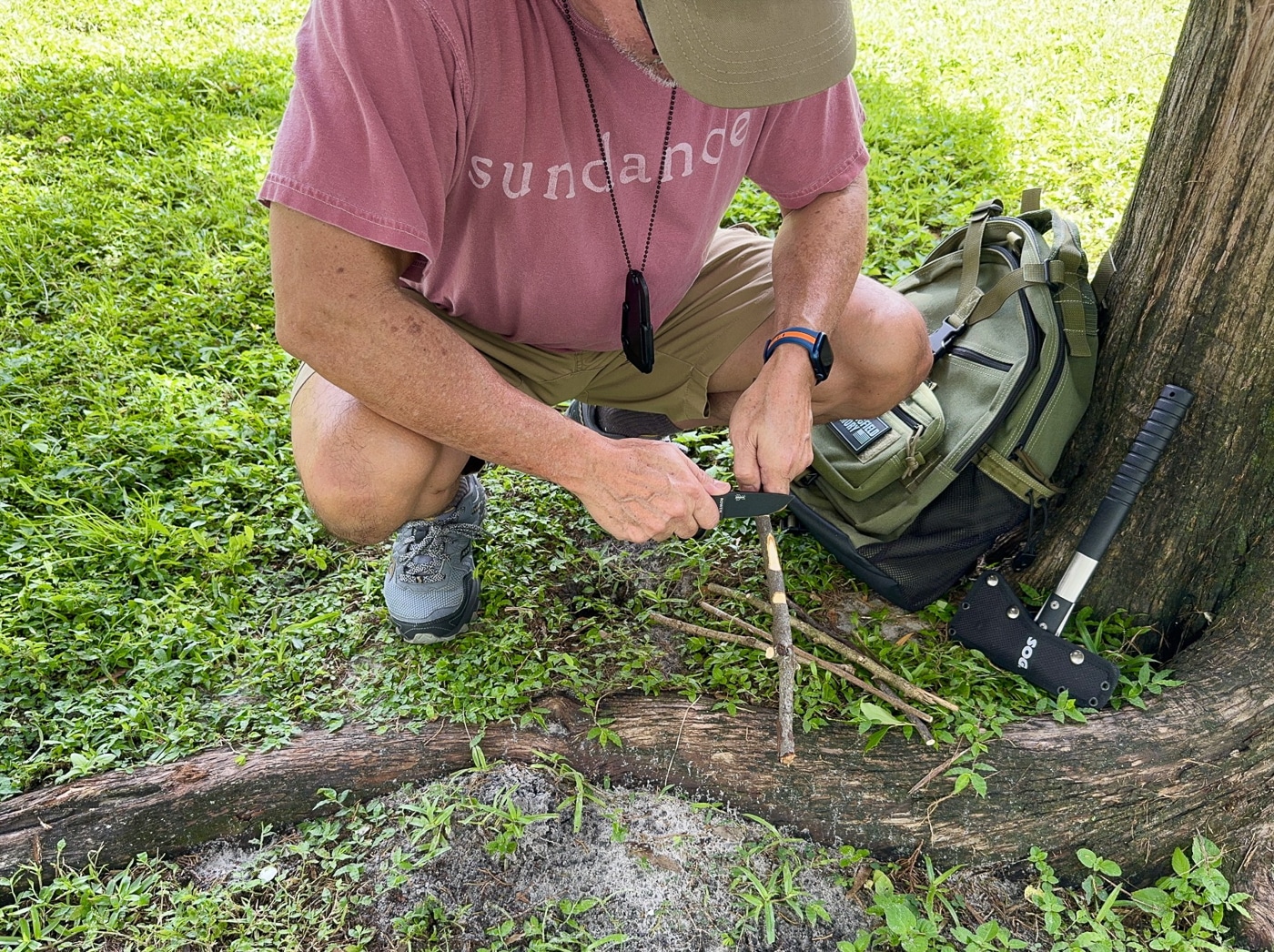
Ball chain of #6 size, at 1/8 inch or 3.2 mm, is acceptable with stainless, carbon steel, and brass tensile strengths of 45, 30, and 20 pounds, respectively. Chains below this are too fragile. Those with larger ball diameters, ranging from 5/32 to 5/8 inch, fail at weights of 65 pounds to 175 pounds. That would put them in the dangerous category. Before the mid-1940s, military dog tags were suspended from a cotton twill tape and were later replaced by a ball chain.
The military specifies dog tag ball chains to be 30 inches in length. The ends of the chain have two-sided connectors into which a single ball is inserted and pulled into a slot. Chains can be shortened by cutting off sections as needed. A neck knife chain should be short enough for the sheath to ride where you find it comfortable.
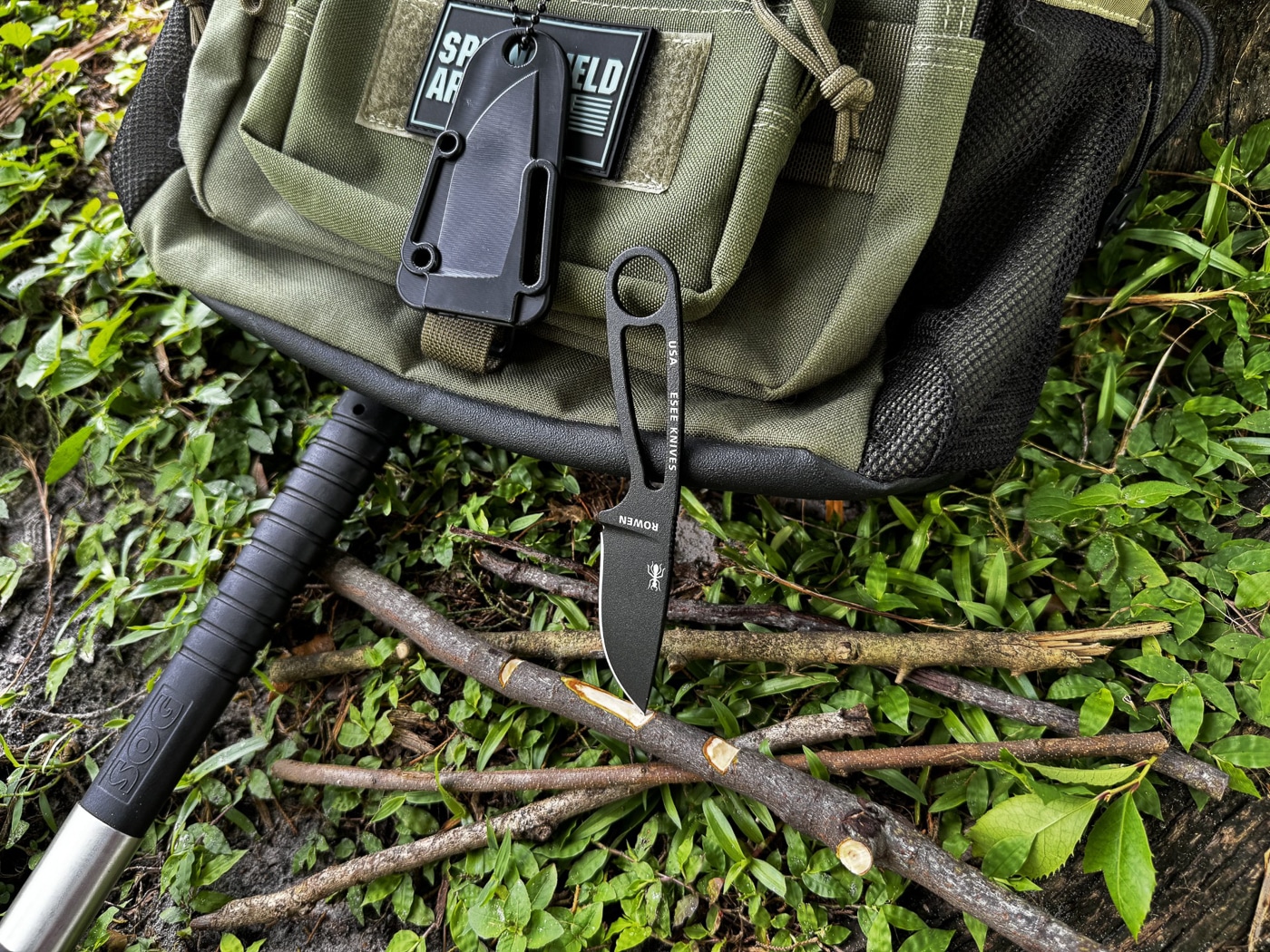
Neck knives also have the versatility of being carried on a belt, in a boot, on a webbing strap or in a pocket. Clips and other attachment points can be added to holes present in most sheaths. For pocket carry, the lanyard can be looped through a belt, allowing the sheath to be pulled away upon drawing the knife. This would be safe for the use of a short length of paracord.
Conclusion
So, the question was, “Are neck knives right for you?” My apologies. A better question might have been, “For what activity is a neck knife right for you?” I found my water knife the right perch. They are handy, versatile and unobtrusive. Whether for protection or production, a blade is for cutting something. A small neck knife can be the one to handle the brunt of the daily tasks, leaving the primary blade keen. Its creative carry is up to you.
Editor’s Note: Please be sure to check out The Armory Life Forum, where you can comment about our daily articles, as well as just talk guns and gear. Click the “Go To Forum Thread” link below to jump in and discuss this article and much more!
Join the Discussion
Featured in this article
Read the full article here




